Michael J. Behe's Blog, page 462
June 28, 2019
Paley’s Ghost speaks out: the problem of [neo-]darwinist evolutionary incrementalism
One of the common weak arguments against the design inference on functionally specific, complex organisation and/or associated information (FSCO/I, a functional form of specified complexity) is the idea that body-plan level macro-evolution is “simply” the accumulation of lots and lots of micro-evolutionary adaptations in a grand climb of fitness.
It seems to be back on the table, so let us highlight its fundamental flaw through an infographic:
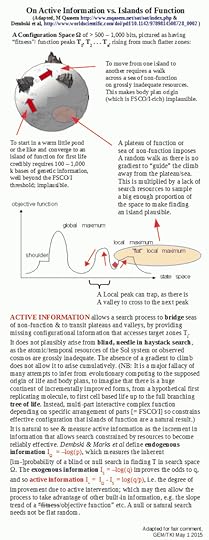
Notice, how easy it is to trap a process that depends on loose-sense hill-climbing.
Where, too, the FSCO/I origin challenge can be similarly summarised:
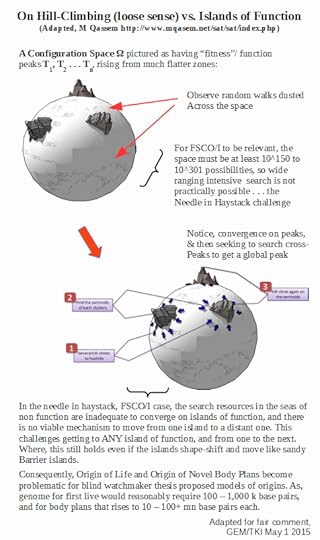
That fitness peaks will naturally occur as islands of function amidst vast seas of non-function should be obvious from the need for correct, matched, properly arranged and coupled parts to attain relevant, coherent functions. The watch is a classic example:
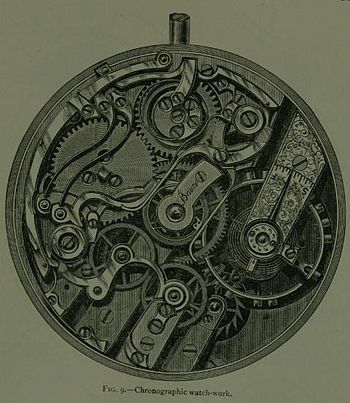 A Watch Movement c. 1880
A Watch Movement c. 1880And, Paley’s observations in Ch 2 of his 1804 Natural Theology on the thought exercise of a self-replicating watch should have been properly addressed by proponents of origin of cell based life and of body plans by incremental, blind watchmaker processes:
NTh, Ch 2: Suppose, in the next place, that the person who found the watch [in a field and stumbled on the stone in Ch 1 just past, where this is 50 years before Darwin in Ch 2 of a work Darwin full well knew about] should after some time discover that, in addition to [–> here cf encapsulated, gated, metabolising automaton, and note, “stickiness” of molecules raises a major issue of interfering cross reactions thus very carefully controlled organised reactions are at work in life . . . ]
all the properties [= specific, organised, information-rich functionality] which he had hitherto observed in it, it possessed the unexpected property of producing in the course of its movement another watch like itself [–> i.e. self replication, cf here the code using von Neumann kinematic self replicator that is relevant to first cell based life] — the thing is conceivable [= this is a gedankenexperiment, a thought exercise to focus relevant principles and issues]; that it contained within it a mechanism, a system of parts — a mold, for instance, or a complex adjustment of lathes, baffles, and other tools — evidently and separately calculated for this purpose [–> it exhibits functionally specific, complex organisation and associated information; where, in mid-late C19, cell based life was typically thought to be a simple jelly-like affair, something molecular biology has long since taken off the table but few have bothered to pay attention to Paley since Darwin] . . . .The first effect would be to increase his admiration of the contrivance, and his conviction of the consummate skill of the contriver. Whether he regarded the object of the contrivance, the distinct apparatus, the intricate, yet in many parts intelligible mechanism by which it was carried on, he would perceive in this new observation nothing but an additional reason for doing what he had already done — for referring the construction of the watch to design and to supreme art [–> directly echoes Plato in The Laws Bk X on the ART-ificial (as opposed to the strawman tactic “supernatural”) vs the natural in the sense of blind chance and/or mechanical necessity as serious alternative causal explanatory candidates; where also the only actually observed cause of FSCO/I is intelligently configured configuration, i.e. contrivance or design]
. . . . He would reflect, that though the watch before him were, in some sense, the maker of the watch, which, was fabricated in the course of its movements, yet it was in a very different sense from that in which a carpenter, for instance, is the maker of a chair — the author of its contrivance, the cause of the relation of its parts to their use [–> i.e. design]. . . . .We might possibly say, but with great latitude of expression, that a stream of water ground corn ; but no latitude of expression would allow us to say, no stretch cf conjecture could lead us to think, that the stream of water built the mill, though it were too ancient for us to know who the builder was. What the stream of water does in the affair is neither more nor less than this: by the application of an unintelligent impulse to a mechanism previously arranged, arranged independently of it and arranged by intelligence, an effect is produced, namely, the corn is ground. But the effect results from the arrangement. [–> points to intelligently directed configuration as the observed and reasonably inferred source of FSCO/I] The force of the stream cannot be said to be the cause or the author of the effect, still less of the arrangement. Understanding and plan in the formation of the mill were not the less necessary for any share which the water has in grinding the corn; yet is this share the same as that which the watch would have contributed to the production of the new watch . . . .
Though it be now no longer probable that the individual watch which our observer had found was made immediately by the hand of an artificer, yet doth not this alteration in anywise affect the inference, that an artificer had been originally employed and concerned in the production. The argument from design remains as it was. Marks of design and contrivance are no more accounted for now than they were before. In the same thing, we may ask for the cause of different properties. We may ask for the cause of the color of a body, of its hardness, of its heat ; and these causes may be all different. We are now asking for the cause of that subserviency to a use, that relation to an end, which we have remarked in the watch before us. No answer is given to this question, by telling us that a preceding watch produced it. There cannot be design without a designer; contrivance, without a contriver; order [–> better, functionally specific organisation], without choice; arrangement, without any thing capable of arranging; subserviency and relation to a purpose, without that which could intend a purpose; means suitable to an end, and executing their office in accomplishing that end, without the end ever having been contemplated, or the means accommodated to it. Arrangement, disposition of parts, subserviency of means to an end, relation of instruments to a use, imply the presence of intelligence and mind. No one, therefore, can rationally believe that the insensible, inanimate watch, from which the watch before us issued, was the proper cause of the mechanism we so much admire in it — could be truly said to have constructed the instrument, disposed its parts, assigned their office, determined their order, action, and mutual dependency, combined their several motions into one result, and that also a result connected with the utilities of other beings. All these properties, therefore, are as much unaccounted for as they were before. Nor is any thing gained by running the difficulty farther back, that is, by supposing the watch before us to have been produced from another watch, that from a former, and so on indefinitely. Our going back ever so far brings us no nearer to the least degree of satisfaction upon the subject. Contrivance is still unaccounted for. We still want a contriver. A designing mind is neither supplied by this supposition nor dispensed with. If the difficulty were diminished the farther we went back, by going back indefinitely we might exhaust it. And this is the only case to which this sort of reasoning applies. “Where there is a tendency, or, as we increase the number of terms, a continual approach towards a limit, there, by supposing the number of terms to be what is called infinite, we may conceive the limit to be attained; but where there is no such tendency or approach, nothing is effected by lengthening the series . . . ,
And the question which irresistibly presses upon our thoughts is. Whence this contrivance and design ? The thing required is the intending mind, the adapted hand, the intelligence by which that hand was directed. This question, this demand, is not shaken off by increasing a number or succession of substances destitute of these properties; nor the more, by increasing that number to infinity. If it be said, that upon the supposition of one watch being produced from another in the course of that other’s movements, and by means of the mechanism within it, we have a cause for the watch in my hand, namely, the watch from which it proceeded — I deny, that for the design, the contrivance, the suitableness of means to an end, the adaptation of instruments to a use, all of which we discover in the watch, we have any cause whatever. It is in vain, therefore, to assign a series of such causes, or to allege that a series may be carried back to infinity; for I do not admit that we have yet any cause at all for the phenomena, still less any series of causes either finite or infinite. Here is contrivance, but no contriver; proofs of design, but no designer. [Paley, Nat Theol, Ch 2]
The unanswered Paley challenge to origin of self-replicating life and to origin of body plans by blind watchmaker incrementalism is on the table. END
Copyright © 2019 Uncommon Descent . This Feed is for personal non-commercial use only. If you are not reading this material in your news aggregator, the site you are looking at is guilty of copyright infringement UNLESS EXPLICIT PERMISSION OTHERWISE HAS BEEN GIVEN. Please contact legal@uncommondescent.com so we can take legal action immediately.
Plugin by Taragana
Jerry Coyne doesn’t like Science Uprising

Science Uprising
It’s true. Darwinian evolutionary biologist Jerry Coyne is not a fan of Science Uprising:
The Discovery Institute has put out a series of videos that, they claim, will do in atheism—and presumably lead us to Intelligent Design and then to Jesus. I hate to give publicity to a bunch of superstitious yahoos, but will put up one sample of what they consider to be a convincing attack on atheism. First, though, the blurbs about these videos.
Jerry Coyne, “Discovery Institute puts out video purporting to refute materialiam and atheism” at Why Evolution Is True
C’mon, Jerry. People are probably reading you in part because you write about them. Cuts all ways.
Luckily, the films were not made to please him. Whew!
Whie we’re here, David Klinghoffer explains the masks in the film, in case you wondered:
Scanning down through the comments section under his [Jerry Coyne’s] post, I noticed a puzzled remark from one reader, “And what is it with that ugly Guy Fawkes mask with the ape nose?” Now perhaps that does deserve a reply. Others have also wondered. The mask is a reference to the 2005 film V for Vendetta, inspired in turn by the historical English rebel Guy Fawkes, and a comic by David Lloyd, who is right when he says it has become “an icon of popular culture,” “a common brand and a convenient placard to use in protest against tyranny.” The ape is of course a reference to evolutionary schemes that insist on human beings as no more than clever apes.
David Klinghoffer, “What’s Up with the Science Uprising Mask?” at Evolution News and Science Today
Jerry really deplores neurosurgeon Michael Egnor so don’t miss his appearances here:
and
If Jerry made his own film, what would it be called? Science Down thudding? 
Michael Egnor takes on buzzwords about “neural networks”
 Michael Egnor
Michael Egnor The ones that supposedly explain the mind:
As I have pointed out repeatedly, and most recently in the short film series Science Uprising, materialist explanations fail to account for many of the most important results in modern neuroscience. Careful examination of a spectrum of the most important experiments in cognitive neuroscience over the past century strongly supports a dualist understanding of the relationship between the mind and the brain. Materialism is an impoverished framework that is antithetical to modern science and particularly to modern neuroscience.
People who are committed to materialist ideology fall back to predictable responses when their ideology is challenged. A common fallback is the one used by commenter Faizai Ali at the website Peaceful Science in response to a recent post on some of my comments in the Science Uprising series.
In reply to my observation that the results of many of the most important experiments in modern neuroscience are most consistent with the dualist, and not the materialist, understanding of the mind, commenter Ali, who describes himself as an “anti-creation psychiatrist”, sniffs:
“Rubbish” …
Michael Egnor, “Can buzzwords about “neural networks” save materialist neuroscience?” at Mind Matters News
See also: Also by Michael Egnor: Science Points To An Immaterial Mind If one did not start with a materialist bias, materialism would not be invoked as an explanation for a whole range of experiments in neuroscience
and
Can physics prove there is no free will?
Follow UD News at Twitter!
Copyright © 2019 Uncommon Descent . This Feed is for personal non-commercial use only. If you are not reading this material in your news aggregator, the site you are looking at is guilty of copyright infringement UNLESS EXPLICIT PERMISSION OTHERWISE HAS BEEN GIVEN. Please contact legal@uncommondescent.com so we can take legal action immediately.
Plugin by Taragana
Feynman, says Massimo Pigliucci, is wrong about beauty and truth in science
A statement attributed to the brilliant oddball Richard Feynman is “You can recognise truth by its beauty and simplicity.” However,
The problem is that it’s difficult to defend the notion that the truth is recognisable by its beauty and simplicity, and it’s an idea that has contributed to getting fundamental physics into its current mess; for more on the latter topic, check out The Trouble with Physics (2006) by Lee Smolin, or Farewell to Reality (2013) by Jim Baggott, or subscribe to Peter Woit’s blog. To be clear, when discussing the simplicity and beauty of theories, we are not talking about Ockham’s razor (about which my colleague Elliott Sober has written for Aeon). Ockham’s razor is a prudent heuristic, providing us with an intuitive guide to the comparisons of different hypotheses. Other things being equal, we should prefer simpler ones. More specifically, the English monk William of Ockham (1287-1347) meant that ‘[hypothetical] entities are not to be multiplied without necessity’ (a phrase by the 17th-century Irish Franciscan philosopher John Punch). Thus, Ockham’s razor is an epistemological, not a metaphysical principle. It’s about how we know things, whereas Feynman’s and Dirac’s statements seem to be about the fundamental nature of reality.
But as the German theoretical physicist Sabine Hossenfelder has pointed out (also in Aeon), there is absolutely no reason to think that simplicity and beauty are reliable guides to physical reality. She is right for a number of reasons.
To begin with, the history of physics (alas, seldom studied by physicists) clearly shows that many simple theories have had to be abandoned in favour of more complex and ‘ugly’ ones. (July 11, 2018)
Massimo Pigliucci, “Richard Feynman was wrong about beauty and truth in science” at Aeon
Hossenfelder’s comments, as above, in Aeon are here.
See also: Massimo Pigliucci: A Burden Of Proof In Science ThatJust Does Not Make Sense First, we are astonished at Pigliucci’s grand claims for the tautology of “natural selection” to produce adaptive complexity which is about as well demonstrated in the real world as magic…
and
Massimo Pigliucci Takes No Prisoners In His War On “Denialism”
Follow UD News at Twitter!
Copyright © 2019 Uncommon Descent . This Feed is for personal non-commercial use only. If you are not reading this material in your news aggregator, the site you are looking at is guilty of copyright infringement UNLESS EXPLICIT PERMISSION OTHERWISE HAS BEEN GIVEN. Please contact legal@uncommondescent.com so we can take legal action immediately.
Plugin by Taragana
Fine-tuning of the universe should be taught in school
As a mental health initiative. When I (O’Leary for News) first heard Bill Nye the Science Guy screaming on the video, I thought he was having a nervous breakdown:
In the fourth episode of the Science Uprising series of short films, cosmologist Lawrence Krauss informs us, arms waving up and down, “If you were designing a universe for life, I suspect that you would design it differently. There is no evidence to design or purpose to our universe.”
Cut to a figure shrieking unintelligibly from the podium at an American Humanist Association meeting, “I suck!” He appears—admittedly, this is entirely a matter of perception from a distance of time and place—to be having (or pretending?) a nervous breakdown.
The figure turns out to be science media personality Bill Nye the Science Guy, named Humanist of the Year in 2010. In the organization’s magazine, he enlarges on the depressing theme, “I suck”. Denyse O’Leary, “Believing in a Purposeful World Is Good Mental Health!” at Mind Matters News
Of course, he may have been doing it for effect. He is, at times, a bit of a showman. That said, if he effectively created the impression, he succeeded in raising the question.
We cut to science notable Freeman Dyson arguing for the fine-tuning of the universe. But, listening to Bill Nye scream “I suck,” one can’t help thinking that believing that we live in a meaningless universe may be a mental health hazard.
See also: What becomes of science when the evidence does not matter?
and
Babylon Bee: Earth cools due to Bill Nye’s ego
Follow UD News at Twitter!
Copyright © 2019 Uncommon Descent . This Feed is for personal non-commercial use only. If you are not reading this material in your news aggregator, the site you are looking at is guilty of copyright infringement UNLESS EXPLICIT PERMISSION OTHERWISE HAS BEEN GIVEN. Please contact legal@uncommondescent.com so we can take legal action immediately.
Plugin by Taragana
June 27, 2019
Researcher asks, Is the cell REALLY a machine?
He offers a bullet list of his reasons for doubt, then an abstract:
Abstract:It has become customary to conceptualize the living cell as an intricate piece of machinery, different to a man-made machine only in terms of its superior complexity. This familiar understanding grounds the conviction that a cell’s organization can be explained reductionistically, as well as the idea that its molecular pathways can be construed as deterministic circuits. The machine conception of the cell owes a great deal of its success to the methods traditionally used in molecular biology. However, the recent introduction of novel experimental techniques capable of tracking individual molecules within cells in real time is leading to the rapid accumulation of data that are inconsistent with an engineering view of the cell. This paper examines four major domains of current research in which the challenges to the machine conception of the cell are particularly pronounced: cellular architecture, protein complexes, intracellular transport, and cellular behaviour. It argues that a new theoretical understanding of the cell is emerging from the study of these phenomena which emphasizes the dynamic, self-organizing nature of its constitution, the fluidity and plasticity of its components, and the stochasticity and non-linearity of its underlying processes. – Author Daniel J. Nicholson Is the cell really a machine? Journal of Theoretical Biology, Volume 477, 21 September 2019, Pages 108-126 (paywall) More.
He does not say here how he would prefer to envision the cell.
Some Darwinians are uncomfortable because the machine metaphor implies design, as Jonathan Wells noted in 2014:
According to pro-evolution philosophers Massimo Pigliucci and Maarten Boudry, “creationists and their modern heirs of the Intelligent Design movement have been eager to exploit mechanical metaphors for their own purposes.” So “if we want to keep Intelligent Design out of the classroom, not only do we have to exclude the ‘theory’ from the biology curriculum, but we also have to be weary [sic] of using scientific metaphors that bolster design-like misconceptions about living systems.” Pigliucci and Boudry conclude that since “machine/information metaphors have been grist to the mill of ID creationism, fostering design intuitions and other misconceptions about living systems, we think it is time to dispense with them altogether.”
But there are better reasons to dispense with the machine metaphor (and Pigliucci and Boudry mention some). Although the mechanistic approach has borne some fruit in biological research, the truth is that living things are very different from machines. Jonathan Wells, “Revolutionary Biology” at Evolution News and Science Today

Cells are more than machines but that only makes any form of Darwinism less likely.
One reader wrote to say that the whole thing reminds him of J. Scott Turner’s Purpose and Desire: What Makes Something “Alive” and Why Modern Darwinism Has Failed to Explain It.
A lot of things would, these days.
Hat tip: Pos-darwinista
Before you go: DNA uses “climbers’ ropes method” to keep tangles at bay It all just swished into place among unthinking cells billions of yours ago. Otherwise we wouldn’t be here. Go tell it on the mountain.
DNA as a master of resource recycling
The amazing energy efficiency of cells: A science writer compares the cell to human inventions and finds that it is indeed amazingly energy-efficient.
In addition to DNA, our cells have an instruction language written in sugar Of course it all just tumbled into existence and “natural selection” somehow organized everything. As if.
Cells find optimal solutions. Not just good ones.
Researchers build “public library” to help understand photosynthesis
Wait. “The part of the plant responsible for photosynthesis is like a complex machine made up of many parts, … ” And machines just happen all by themselves, right? There is no information load to account for; it just evolved by natural selection acting on random mutation the way your Android did!
In Nature: Cells have “secret conversations” We say this a lot: That’s a lot of information to have simply come into being by natural selection acting on random mutation (Darwinism). It’s getting not only ridiculous but obviously ridiculous.
Follow UD News at Twitter!
Researchers: Helpful gut microbes send messages to their hosts If the strategy is clearly identified, they should look for non-helpful microbes that have found a way to copy it (horizontal gene transfer?)
Cells and proteins use sugars to talk to one another Cells are like Neanderthal man. They get smarter every time we run into them. And just think, it all just tumbled into existence by natural selection acting on random mutations (Darwinism) too…
Researchers: First animal cell was not simple; it could “transdifferentiate” From the paper: “… these analyses offer no support for the homology of sponge choanocytes and choanoflagellates, nor for the view that the first multicellular animals were simple balls of cells with limited capacity to differentiate.”
“Interspecies communication” strategy between gut bacteria and mammalian hosts’ genes described
Researchers: Cells Have A Repair Crew That Fixes Local Leaks
Researchers: How The Immune System “Thinks”
Follow UD News at Twitter!
Researcher: Mathematics Sheds Light On “Unfathomably Complex” Cellular Thinking
How do cells in the body know where they are supposed to be?
Researchers A Kill Cancer Code Is Embedded in Every Cell
Copyright © 2019 Uncommon Descent . This Feed is for personal non-commercial use only. If you are not reading this material in your news aggregator, the site you are looking at is guilty of copyright infringement UNLESS EXPLICIT PERMISSION OTHERWISE HAS BEEN GIVEN. Please contact legal@uncommondescent.com so we can take legal action immediately.
Plugin by Taragana
Researchers: Evolution is random, just like the stock market…
Are these people allowed to say this? From ScienceDaily:
Remarkably, extreme events of diversification and extinction happen more frequently than a typical, Gaussian, distribution would predict. Instead of the typical bell-shaped curve, the fossil record shows a fat-tailed distribution, with extreme, outlier, events occurring with higher-than-expected probability.
While scientists have long known about this unusual pattern in the fossil record, they have struggled to explain it. Many random processes that occur over a long time with large sample sizes, from processes that produce school grades to height among a population, converge on the common Gaussian distribution. “It’s a very reasonable default expectation,” says Santa Fe Institute Omidyar Fellow Andy Rominger. So why doesn’t the fossil record display this common pattern?
In a new paper published in Science Advances, Rominger and colleagues Miguel Fuentes (San Sebastián University, Chile) and Pablo Marquet (Pontifical Catholic University of Chile) have taken a new approach to tackling this question. Instead of trying to only describe fluctuations in biodiversity across all types of organisms, they also look at fluctuations within clades, or groups of organisms that share a common ancestral lineage.
“Within a lineage of closely related organisms, there should be a conserved evolutionary dynamic. Between different lineages, that dynamic can change,” says Rominger. That is, within clades, related organisms tend to find an effective adaptive strategy and never stray too far. But between these clade-specific fitness peaks are valleys of metaphorically uninhabited space. “It turns out, just invoking that simple idea, with some very simple mathematics, described the patterns in the fossil record very well.”
These simple mathematics are tools that Fuentes, in 2009, used to describe another system with an unusual fat-tailed distribution: the stock market. By using superstatistics — an approach from thermodynamics to describe turbulent flow — Fuentes could accurately describe the hard-to-predict dramatic crashes and explosions in value.
“In biology, we see these crashes and explosions too, in terms of biodiversity,” says Rominger. “We wondered if Fuentes’ elegant approach could also describe the evolutionary dynamics we see in the fossil record.” Paper. (open access) – Andrew J. Rominger, Miguel A. Fuentes and Pablo A. Marquet. Nonequilibrium evolution of volatility in origination and extinction explains fat-tailed fluctuations in Phanerozoic biodiversity. Science Advances, 2019 DOI: 10.1126/sciadv.aat0122 More.
Maybe these people sort of know they are offering an intelligence-based explanation if they invoke the stock market. Maybe they don’t.
Are they trying to surrender quietly?
See also: What the fossils told us in their own words
Follow UD News at Twitter!
Copyright © 2019 Uncommon Descent . This Feed is for personal non-commercial use only. If you are not reading this material in your news aggregator, the site you are looking at is guilty of copyright infringement UNLESS EXPLICIT PERMISSION OTHERWISE HAS BEEN GIVEN. Please contact legal@uncommondescent.com so we can take legal action immediately.
Plugin by Taragana
June 26, 2019
Darwin’s fossils freak out over ID in Brazil
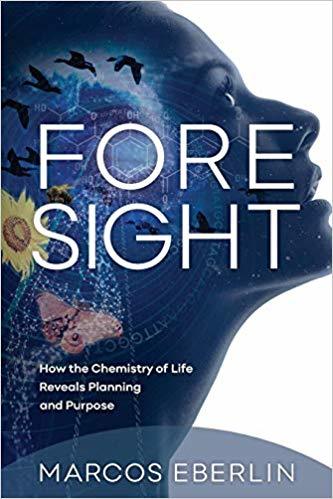
Marcos Eberlin got their goat, we don’t doubt. Open access:
From the Final Remarks: Science, as a process, starts with the acceptance of our ignorance about a natural phenomenon and by seeking natural explanations for it. Hence, ignorance drives the engine of Science. Even if evolution were, hypothetically, rejected, contested by new data, scientists would have to study hard to find an alternative natural explanation that was able to explain everything that evolution explains today plus the new data that contested it.
Evolution is a fact and a well-supported scientific theory. It has endured daily and rigorous testing, and it stands as the unifying theory in biology (Rutledge and Warden, 2000). This says nothing about whether God created or did not create the world, as science is unable to distinguish a divinely guided evolution from a materialistic evolution. God may well have created the biological world through natural selection, mutation, speciation, extinction, etc. Still, evolution and Science would remain unscathed as Science is not concerned with why or who, but only with how.
Some creationists say that we must bring the evolution versus creationist debate to the classroom and claim that the opposition to the debate is anti-scientific. However, science is not about blind criticism (Meyer and El-Hani, 2013). Blind criticism is just as naïve as blind acceptance. Scientists must weigh the evidence before questioning a theory. The idea that all debates are equally scientific is misleading and it explains the sad emergence of flat-earthers and anti-vaxxers. A debate on what is the shape of our planet is not only pointless, but it is also dangerously harmful to the minds of the young students. A fruitful debate in a science class is restricted to those issues that lie within the scientific realm (Baltzley, 2016, Branch, 2016).
A recent study has suggested that science concepts, more than evolutionary basics, are critical to promoting evolution (Dunk et al., 2017). One way to reinforce these fundamentals would be the requirement of evolution and science fundaments in admission policies for biology professionals, particularly teachers (Larkin and Perry-Ryder, 2015; see Rutledge and Warden, 2000 for statistics). Claudia A.M. Russo and Thiago André, Genetics and Molecular Biology, Print version ISSN 1415-4757On-line version ISSN 1678-4685 Genet. Mol. Biol. vol.42 no.1 Ribeirão Preto Jan./Mar. 2019 Epub Feb 28, 2019 http://dx.doi.org/10.1590/1678-4685-g...
More.
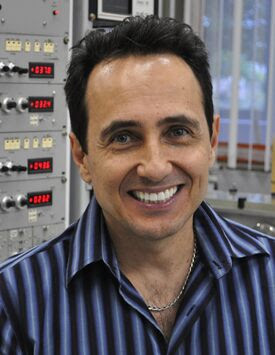
It’s those orchids, right? We always said, in the Uncommon Descent News virtual coffee room, it was those orchids that did in Darwin in Brazil. Oh yes, and Marcos Eberlin, of course.
See also: Jerry Coyne is already mad at Marcos Eberlin
and
Marcos Eberlin shouldn’t exist/
Copyright © 2019 Uncommon Descent . This Feed is for personal non-commercial use only. If you are not reading this material in your news aggregator, the site you are looking at is guilty of copyright infringement UNLESS EXPLICIT PERMISSION OTHERWISE HAS BEEN GIVEN. Please contact legal@uncommondescent.com so we can take legal action immediately.
Plugin by Taragana
Nobody went downhill faster than DNA
Remember when everything you ever were or would be was
in your DNA? Now it’s proteins:
Previously, scientists had recovered proteins from 1.8-million-year-old animal teeth and a 3.8-million-year-old eggshell. Now, they hope that palaeoproteomics could be used to provide insights about other ancient hominin fossils that have lost all traces of DNA — from Homo erectus, which roamed parts of the world from about 1.9 million to 140,000 years ago, to Homo floresiensis, the diminutive ‘hobbit’ species that lived in Indonesia as recently as 60,000 years ago. By looking at variations in these proteins, scientists hope to answer long-standing questions about the evolution of ancient human groups, such as which lineages were direct ancestors of Homo sapiens. “I think that you can basically unlock the whole of the human tree,” says Matthew Collins, a bioarchaeologist at the University of Copenhagen who has been at the forefront of the field since the 1980s, when it consisted of just a handful of researchers.
Matthew Warren, “Move over, DNA: ancient proteins are starting to reveal humanity’s history” at Nature
We never told you to believe those DNA people. And we just report this.
See also: There’s a gene for that… or is there?
Follow UD News at Twitter!
Copyright © 2019 Uncommon Descent . This Feed is for personal non-commercial use only. If you are not reading this material in your news aggregator, the site you are looking at is guilty of copyright infringement UNLESS EXPLICIT PERMISSION OTHERWISE HAS BEEN GIVEN. Please contact legal@uncommondescent.com so we can take legal action immediately.
Plugin by Taragana
SETI: Four origin of life scientists imagine the beginning
We invited talented scientists to discuss their different opinions about the origin of life and the site of life’s origin. Most of them will agree that liquid water was necessary, but if we had a time machine and went back in time, would we find life first in a hydrothermal submarine setting in sea water or a fresh water site associated with emerging land masses? Biologist David Deamer, a Research Professor of Biomolecular Engineering at the University of California, Santa Cruz, and multi-disciplinary scientist Bruce Damer, Associate Researcher in the Department of Biomolecular Engineering at UC Santa Cruz, will describe their most recent work, which infers that hydrothermal pools are the most plausible site for the origin of life. Both biologists have been collaborating since 2016 on a full conception of the Terrestrial Origin of Life Hypothesis.
“Where is the origin of life on Earth?” at SETI
Bring your own snacks and pillow.
See also: The Science Fictions series at your fingertips – origin of life What we do and don’t know about the origin of life.
Follow UD News at Twitter!
Copyright © 2019 Uncommon Descent . This Feed is for personal non-commercial use only. If you are not reading this material in your news aggregator, the site you are looking at is guilty of copyright infringement UNLESS EXPLICIT PERMISSION OTHERWISE HAS BEEN GIVEN. Please contact legal@uncommondescent.com so we can take legal action immediately.
Plugin by Taragana
Michael J. Behe's Blog
- Michael J. Behe's profile
- 219 followers



